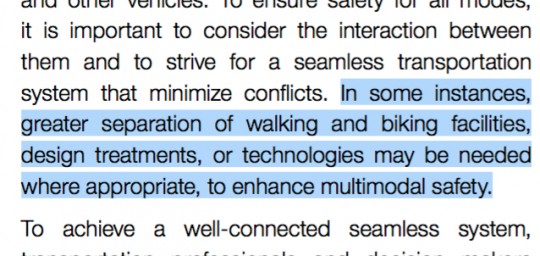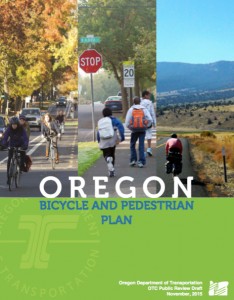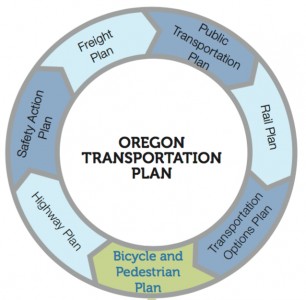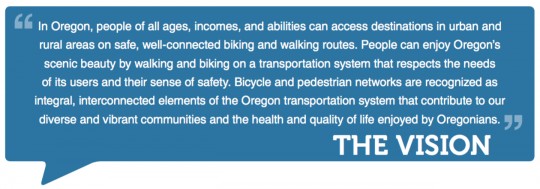The Oregon Department of Transportation has released a draft of their new Bicycle and Pedestrian Plan.
This plan is the result of two and-a-half years of meetings and outreach and it’s the first time ODOT has updated its biking and walking plan since 1995 (an update to their design guide in 2011 notwithstanding). It’s a crucial document because the policies and strategies in this plan will set the framework for what ODOT decides to build going forward.
A coalition of transportation advocates that includes the Bicycle Transportation Alliance, Oregon Walks, the Sustainable Transportation Council, the Oregon chapter of the Safe Routes to School National Partnership, and two members of the plan’s own advisory committee have already penned a letter to ODOT with their concerns about the plan.
We’ll be taking a closer look at the plan in the coming weeks. At first glance it appears to be a solid start, but could use some strenthening in order to make a real impact.
The reason it’s so important for us to get this right is because unlike the existing 1995 plan – which was just a “staff-level” document without the power internally to influence big decisions, this new plan is what ODOT refers to as a “modal plan.” That’s an important distinction. According to ODOT, this plan will be “equal in stature” to its Highway Plan, Rail Plan, Freight Plan, and so on.
That’s why we’re a bit concerned that some of the sections aren’t quite as strong as they should be; like this passage from the Introduction (emphasis mine):
“To ensure safety for all modes, it is important to consider the interaction between them and to strive for a seamless transportation system that minimize conflicts. In some instances, greater separation of walking and biking facilities, design treatments, or technologies may be needed where appropriate, to enhance multimodal safety.“
Plans are notorious for not really mattering when push comes to shove, so it’s extremely important that you start from a position of strength. By stating that separation — which most planners these days consider a minimum standard treatment — is only necessary “in some instances… where appropriate” just sets ODOT up for falling short of their goals. (And does anyone really know (or care) what “enhance multimodal safety” means?)
We are glad to see that a coalition of transportation advocates are already on this case. In a letter (PDF) with their feedback on the plan, they’ve urged ODOT to use stronger and clearer language when it comes to safety. “Equivocation in the language throughout the plan’s policies and strategies,” they write, “dramatically undermines its intent.”
Advertisement
Here’s more from the coalition:
“Creating safe streets for people walking and biking requires narrower travel lanes, slower vehicle speeds, more physical protection, more sidewalks and bike lanes, and savvy and comprehensive public education. Nowhere in the plan language is this direct and well-understood approach to safety made into policy. This omission will not serve Oregonians of all ages walking and biking now or in the future.”
In terms of the future, ODOT has created this vision statement, which they hope to achieve by 2040:
And to get there, ODOT estimates they’ll need over one billion dollars:

There are some good intentions in the plan, but if ODOT wants to achieve that vision there needs to be more specificity, accountability and commitment.
For instance, I was happy to see that ODOT has included the concepts of Bicycle Level of Traffic Stress and Multimodal Level of Service — two methodologies of prioritizing projects that go beyond simply taking into account how much delay someone in a car would experience (the dreaded Level of Service standard that’s currently used by default). But while these concepts are included the plan, ODOT stops short of endorsing them or making a commitment to actually use them.
And there are no specific projects in this plan. ODOT says that’s by design, and that project lists will be decided later with the plan acting as a guide. But if this plan is to have any teeth, some commitments to specific routes and projects need to be put down on paper.
One encouraging item in the plan is Goal 4: Community and Economic Vitality. It’s good to see the state solidify its focus on how bicycling and walking can be tools to create tourism revenue and build community in both urban and rural areas.
You can view the entire plan at Oregon.gov. To share your feedback directly with ODOT, email them through February 18th at ORBikePedPlan@odot.state.or.us. Stay tuned for an online open house hosted by ODOT in mid-December.
— Jonathan Maus, (503) 706-8804 – jonathan@bikeportland.org





